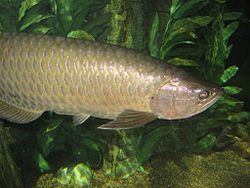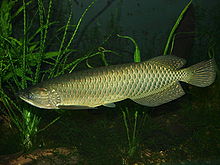From Wikipedia, the free encyclopedia
| Gulf saratoga |
 |
| Conservation status |
Least Concern (IUCN 3.1)[1] |
| Scientific classification |
| Kingdom: | Animalia |
| Phylum: | Chordata |
| Class: | Actinopterygii |
| Order: | Osteoglossiformes |
| Family: | Osteoglossidae |
| Subfamily: | Osteoglossinae |
| Genus: | Scleropages |
| Species: | S. jardinii |
| Binomial name |
Scleropages jardinii
(Saville-Kent, 1892) |
The
gulf saratoga,
Scleropages jardinii, is a freshwater bony fish native to Australia, one of two species of fishes sometimes known as Australian arowanas, the other being the saratoga (
S. leichardti). It has numerous other common names, including northern saratoga, Australian bonytongue, toga and barramundi (not to be confused with the barramundi perch,
Lates calcarifer). It is a member of the subfamily Osteoglossinae, a (basal) teleost group. Its scientific name is sometimes spelled
S. jardini.
S. jardinii is found in both fast-moving and still waters of northern Australia and New Guinea. It is not considered endangered or threatened by either the CITES conventions nor the IUCN Red List.
Contents- 1 Description
- 2 See also
- 3 External links
- 4 References
|

Subadult gulf saratoga at New York Aquarium
This fish has a long, dark-colored body with seven rows of large scales, each with several reddish or pinkish spots arranged in a crescent shape around the trailing edge of the scale, giving it a pearly appearance. Its has large, wing-like pectoral fins. Except for duller coloration and smaller scale size, it appears very similar to the Asian arowana,
S. formosus. It grows to a length of about 90 cm (35 in.). Its maximum weight is recorded as 17.2 kg (38 lb.), but one report suggests it has been known to weigh as much as 27 kg (59 lb.). The depth of the bodies of adults is approximately 25-28% of the Standard Length, making this a more robust fish than its Australian cousin
S. leichardti.
Like other arowanas, it is a mouthbrooder, but unlike the Asian Arowana, reports suggest the female rather than the male broods the young in her mouth.
Due to their resemblance to the Asian arowanas they are sometimes sold in the name of golden arowana in some of the Asian countries, like India. However they can be easily distinguished from the Asian arowanas by identifying their red spotted fins & 7-8 rows of scales on their body.




























No comments:
Post a Comment